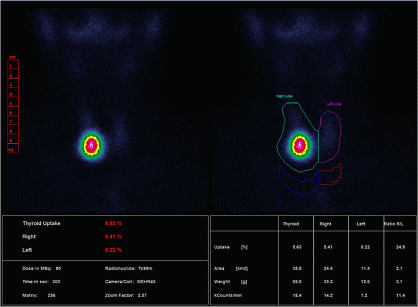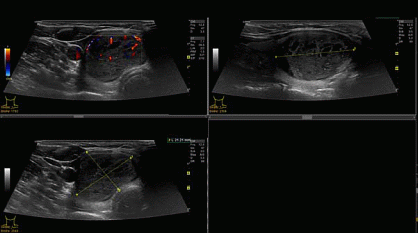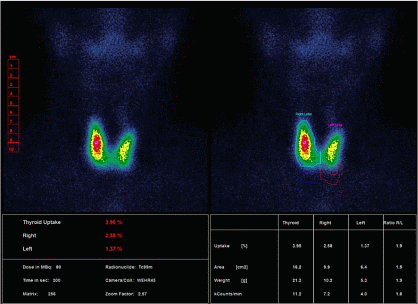ECE2022 Poster Presentations Thyroid (136 abstracts)
A case of the uncommon Marine-Lenhart syndrome
Maria Mathiopoulou 1 & Ivette Engel-Bicik 2
1University Hospital of Zurich, Thyroid Center, Nuclear Medicine, Zurich, Switzerland; 2 University Hospital of Zurich, Nuclear Medicine, Zurich, Switzerland
Background: The combination of a toxic adenoma and Graves’ disease compose the Marine-Lenhart syndrome. This condition is estimated to occur in 0.8-2.7% of Graves’ disease patients and only few cases are reported in the literature.
Patient findings: A 29-year-old female patient was referred to our outpatient clinic due to subclinical hyperthyroidism and a newly discovered thyroid nodule on the right thyroid lobe. She had no thyreotoxic symptoms and the clinical examination was unremarkable. Her initial blood tests were: TSH 0.01 mU/l (reference 0.16-4.25 mU/l), fT3 8.3 pmol/l, (reference 3.6-6.4 pmol/l), fT4 15.6 pmol/l (reference 12.3-20.2 pmol/l) and TSH-Receptor-Ab titers < 0.30 U/l (reference < 1.75 U/l). The thyroid ultrasound and scintigraphy revealed a toxic adenoma in a right sided goiter. Following a radioiodine ablation with 200 MBq 131-I was performed. follow-up ultrasound after six months revealed a 70% volume reduction of the formerly toxic adenoma of (2.6 ml, pre-therapy 8.7 ml). Two months later at the regular after-therapy follow-up, a manifest hyperthyroidism was revealed [TSH 0.004 mU/l, (reference 0.10-4.00 mU/l), fT3 28.1 pmol/l (reference 3.0-9.5 pmol/l) and fT4 21.4 pmol/l (reference 10.0-28.0 pmol/l)] and the TSH-Receptor-Ab titers were elevated [1.85 U/l (reference < 1.75 U/l)]. The patient was still completely asymptomatic. The thyroid scintigraphy was repeated and showed a symmetrical, elevated radionuclide uptake, leading to the diagnosis of Graves’ disease. A thyrostatic therapy with carbimazole was initiated and continued for 8 months, until the thyroid function markers in the blood were normalised.
Conclusion: The existence of both a toxic adenoma and a Graves’ disease in the same patient has been termed as Marine-Lenhart syndrome. This coexistence may be observed simultaneously or in different stages, according to the bibliography. In cases where radioiodine treatment of a toxic adenoma is indicated, attention is required, because it may trigger the Graves’ disease, as shown in this case. Every new presentation of hyperthyroidism should be investigated as a new pathology, as it may reveal a new underlying condition indicating the need for different therapeutical pathways.
Photos
Thyroid scintigraphy 09.06.2020
Thyroid ultrasound 09.06.2020
Thyroid scintigraphy 18.01.2021


 }
}



